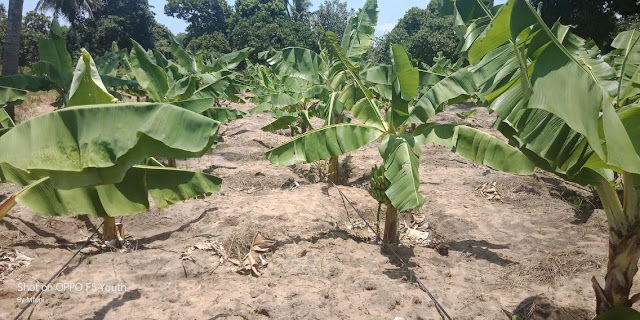Banana is one of the staple food crops grown in Kenya for both home consumption and for markets. Bananas are widely grown in most parts of Kenya for cooking and dessert. A few Kenyan farmers who know about tissue culture bananas grow the dual-purpose banana varieties that can be used both for dessert and cooking. The popularity of the crop makes it a good cash crop for the Kenyan smallholder farmers, who can sell the produce even at their farm gate.
The ripe fruit of banana is a good source of vitamins A, B6, C and Potassium. Cooked bananas are rich in carbohydrates. Recently processing of bananas has gained momentum here and bananas are being processed into flour, canned slices, jam, jelly, puree, vinegar, wine and beer. Demand for these processed products is expected to go up in the coming years, making the market even larger for banana growers in Kenya.
So if you want to do successful commercial banana farming in Kenya, what are the factors that you should consider? We shall discuss all these factors in this article and if we miss out something, kindly ask in the comments section below.
Optimal Ecological Requirements for Banana Farming in Kenya
Banana grows in the tropics; that is the area between the tropic of Cancer and the tropic of Capricorn. Our entire country Kenya lies squarely in this region and being that banana farming is favored by a wide range of agro-climatic conditions, you can grow them almost anywhere in this country.
The crop grows well in hot and humid conditions of altitude between 0-1800 m above the sea level: that’s all the way from as low as Mombasa to as high as Kisii with the exception of the very cold highlands. With a rainfall range of 1000-2000 mm/year or sufficient water for irrigation, you are good to go.

Optimal temperature of 270 C is preferred for banana growing. However it still does well in temperature range of 20- 300C. Deep well drained soils rich in organic matter are required for the growing of bananas with a pH of between 6.0 and 7.5. Spacing is important in banana growing so as to ensure adequate accessibility of the required resources by the plant. The planting whole should be big, measuring about 60*60*60 cm and spaced 3x3m.
Banana Varieties in Kenya
Banana varieties which are predominantly grown in Kenya include; Uganda green, ngombe, Gradi shiskame and mutahato for cooking varieties while dessert varieties include; apple banana, bokoboko, giant Cavendish, Chinese Cavendish, Gros Michel and muraru. FHIA 17 is a dual purpose variety and is mostly produced through tissue culture. Banana farmers select their preferred varieties based on tastes, eating habits, market demand and environmental conditions.
Banana Propagation
Bananas are propagated vegetatively by use of cutting, suckers and Tissue culture. The main method of banana propagation by most smallholder farmers is by division of suckers which arise from the base of the main stem, or from the underground corm. This method of banana propagation is used by most farmers as it is cheap and favorable cultivars of bananas are maintained. Additionally, use of suckers for propagation is easy and does not necessarily require skilled labor. However, there are many disadvantages associated with the use of suckers as a method of propagation. The main ones are:
- Suckers perpetuate the spread of banana diseases and pests.
- Variation in age and size of sucker, hence the crop is not uniform which leads to difficulty in managing the crop and harvesting.
Tissue Culture Banana in Kenya
Tissue culture also referred to as micro propagation is the science of multiplying clean disease-free planting materials of different crops to have many identical copies of the same variety without altering the taste and other physical attribute of the plant. Tissue culture work is mainly done in the laboratories and then the plants are raised in the nursery beds where farmers can access for planting. Advantages associated with the use of Tissue culture include:
- Elimination of the risk of pests and diseases
- Tissue culture is the most rapid method of propagating bananas and increased yields of the bananas.
- Use of TC ensures a timely large turnover of clean planting materials within a limited space.
- Tissue cultured banana plants produce uniform maturity of the fruits which make harvesting process easy and reduce labor cost.
Some of the disadvantages of TC include:
- It’s an expensive method of propagation as it involves laboratory experiments.
- Reduction in the genetic diversity of the banana due to the fact that all plants are genetically similar.
- TC technique is still new to many smallholder farmers in Kenya as it requires skilled personnel to carry out.
However, you do not have to worry about the expenses of setting up tissue culture labs and the technicalities associated with it. That has been done for you by Richfarm Kenya and all you need to do is order the variety you need and you get ready tissue culture banana seedlings for planting.

From the above foregoing it is worth noting that TC is the best method of banana propagation in Kenya and efforts need to be put on high gear to ensure banana farming in Kenya is enhanced by embracing Tissue Culture as a means of ensuring food security as far as banana production is concerned.
Smallholder farmers who contribute to the largest share of the banana farming in Kenya community need to come up together and collectively pull resources to be able to benefit from the profits associated with TC banana propagation, as it is the most viable method to ensure that maximum profitability is attained.
Credit: Source link